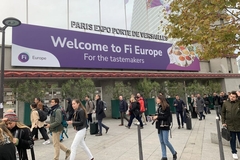
- Industry news
Industry news
- Category news
Category news
- Reports
- Key trends
- Multimedia
- Journal
- Events
- Suppliers
- Home
- Industry news
Industry news
- Category news
Category news
- Reports
- Key trends
- Multimedia
- Events
- Suppliers
EFSA Offers Reasoned Opinion on Modification of Existing MRLs for Flutriafol in Various Crops

EFSA concludes that the proposed MRLs are not acceptable for table grapes and soya beans. The proposed MRLs for wine grapes, bananas and apples are acceptable as they will not raise any consumer health concerns.

19 Apr 2010 --- According to Article 6 of the Regulation (EC) No 396/2005, the United Kingdom received an application from Cheminova A/S to set import tolerances for flutriafol in apples, grapes, bananas, soya beans, peanuts and coffee beans. After the evaluation of the import tolerance application, the EMS concluded that the EC MRLs would have to be modified for apples, bananas, grapes and soya beans in order to support the international trade. For coffee beans and peanuts the residue data set submitted by the applicant identified no need to modify the existing EC MRLs set for these crops. The RMS United Kingdom drafted an evaluation report according to Article 8 of Regulation (EC) No 396/2005 which was submitted to the European Commission and forwarded to EFSA on 19 November 2009.
It has to be noted that flutriafol has not been yet peer reviewed under Directive 91/414/EEC and therefore all conclusions reached in this reasoned opinion have to be considered as provisional and might need to be revised in the light of the outcome of the peer review, EFSA stressed.
EFSA derived the following conclusions based on the above mentioned evaluation report as well as the Draft Assessment Report prepared by the RMS United Kingdom under Directive 91/414/EEC. The toxicological profile of flutriafol has been investigated for the peer review and the RMS derived proposals for an ADI of 0.01 mg/kg bw/d and an ARfD of 0.05 mg/kg bw.
The metabolism of flutriafol is elucidated in cereal and fruit crop groups. The crops, for which the import tolerance requests are made, belong to crop groups of fruits (banana, apples, grapes) and pulses and oilseeds (soya beans). EFSA concludes that the metabolism of flutriafol residues is sufficiently addressed in fruit crops under consideration and additional studies are not necessary. Pending the outcome of the peer review, a provisional risk assessment and enforcement residue definition in fruit crops under consideration can be established as parent flutriafol. The metabolic pattern of flutriafol residues in crops belonging to the crop group of pulses and oilseeds (relevant for soya beans) has not been investigated. For this crop group no conclusion on a residue definition can be drawn. Adequate analytical enforcement methods are available to control the compliance of the proposed MRLs according to the enforcement residue definition.
Submitted residue trials data indicate that a MRL of 0.2 mg/kg would be required for apple, 1 mg/kg for grapes and 0.3 mg/kg for banana to support the authorized non-European GAPs. According to supervised residue trials data, a MRL of 0.3 mg/kg would be required for soya beans but it cannot be supported due to data gaps identified regarding the nature of flutriafol residues plants.
The investigation of nature and magnitude of flutriafol residues in rotational crops is of no relevance for the import tolerance request. There are no studies available investigating the effects of processing on the nature and magnitude of flutriafol residues. EFSA recommends performing such studies taking into account the wide range of authorized uses of flutriafol as well as high consumer exposure to flutriafol residues from the intake of crops that might be consumed processed. In particular, a processing study for wine would be required because of the significant chronic intake.
The livestock exposure to flutriafol residues was investigated considering both the existing MRLs and proposed MRLs for flutriafol. The dietary burden calculation was hampered by the lack of data on the authorized GAPs and therefore has to be considered as indicative. The trigger value of 0.1 mg/kg DM was exceeded for all types of livestock and was driven by the existing uses of flutriafol on cereals. The contribution of residues in apple pomace does not significantly affect the livestock dietary burden and therefore the need for the setting of MRLs was not further investigated in the framework of this application. However, the setting of MRLs for flutriafol in commodities of animal origin is recommended by EFSA and has to be considered in the framework of comprehensive MRL review under Article 12(1) of Regulation (EC) No 396/2005.
The consumer exposure assessment to flutriafol residues was performed with revision 2 of the EFSA PRIMo. For the calculation of the chronic exposure EFSA used the existing MRLs as established in Annex III of Regulation (EC) No 396/2005 as well as the STMR values as derived from the supervised residue field trials for apples, banana and grapes. The acute exposure assessment was performed only with regard to crops under consideration (excluding soya beans). The relevant HR values as derived from the residue trials were used as input values in the acute exposure assessment.
The short-term consumer health risk could not be excluded from the intake of table grapes treated with flutriafol (116.6 % of the ARfD). For other crops – bananas, apples, wine grapes- no acute health risks were associated with the proposed import tolerance MRLs.
No long-term consumer health risks were identified for any of the European diets. Excluding table grapes from the calculation, the total calculated dietary exposure accounted for a maximum of 98.3% of the ADI. The highest individual contribution from the crops under consideration was identified for wine grapes (13.6%; French population diet) followed by apples (8.45%; DE child diet) and bananas (1.54%; SE general population diet).
EFSA concludes that the proposed MRLs are not acceptable for table grapes and soya beans. The proposed MRLs for wine grapes, bananas and apples are acceptable as they will not raise any consumer health concerns.











